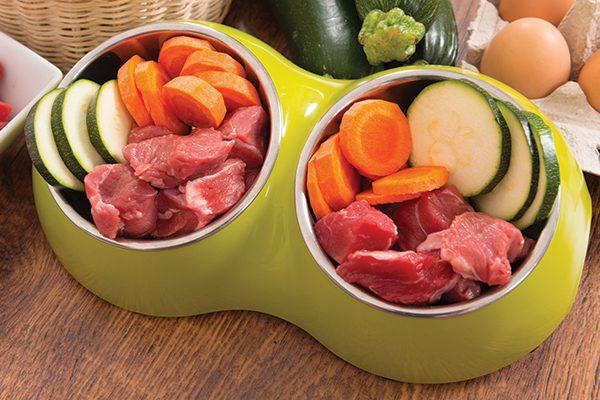
By Roxanne Stone, Vice President of Research and Development for Answers Pet Food
At Answers Pet Food, our philosophy on pet nutrition is fairly simple. We believe Mother Nature is the best authority on proper animal nutrition and it’s difficult to argue otherwise. A quick glimpse into observing the diets of canine ancestors, as well as their wild counterparts—the wolves, is all that is necessary to gain a good understanding of their basic diet and what makes them thrive.
Once most pet owners do even a small amount of research on dog or cat nutrition, the decision to feed raw is obvious. We encourage all pet owners to become educated on the basics of pet nutrition so they have the knowledge and tools to make the best choice in feeding their pets.
Historically, it has only been in recent years (about 80 years ago), that our pets have been introduced to the highly processed, sterile, grain based, enzyme deficient, modern diet. Prior to this, they consumed a raw, protein-based diet either through hunting smaller animals and rodents or from the raw bone and meat scraps they received from their human caretakers.
It isn’t surprising that we can observe a parallel in the same degenerative diseases and allergies in our pet populations that we see in our own human population, as humans have also moved to this highly processed, high carbohydrate diet.
Dr. Karen Becker, DVM and licensed Naturopathic Medical Doctor, clearly explains that the short G.I. tracts of dogs and cats (carnivores) are not designed to digest large amounts of carbohydrates, which unfortunately are the base of most commercial pet foods. Rather, they are intended to digest raw protein based diets. Dr. Becker links many of the following diseases to the high carbohydrate, grain based pet food diets including;
• chronic skin conditions
• auto-immune diseases
• allergies
• urinary tract infections
• kidney stones
• degenerative joint disease
• and cancer
…just to name a few.
Many pet owners who see the nutritional benefits of raw are reluctant to try it for fear of harmful bacteria. Dr. Doug Knueven, DVM and author of The Holistic Health Guide, Natural Care For The Whole Dog, mentions that in his experience, pathogens such as E. Coli and Salmonella, are rarely a problem for dogs and they are able to handle these bacteria much the same way their ancestors have for millennia.
We agree that healthy pets with well developed gut micro-flora should not experience any ill effects from consuming raw meat. However, Answers Pet Food also takes food safety and manufacturing to the highest level when sourcing and preparing our products. We understand that reducing the risk of harmful bacterial contamination starts at the farm, and in the manner the livestock are raised, fed, and handled. All of our raw meat ingredients are sourced from livestock that are free-range, pasture-fed, and have never ever been administered growth hormones or antibiotics. Our raw meat ingredients are from USDA inspected facilities and are passed for human consumption.
Answers puts strict quality control measures in place at our manufacturing facility (also USDA inspected) to control pathogens. In fact, many of our ingredients are delivered fresh and processed upon arrival to deliver the highest quality end product. In addition, we use one of the most traditional methods in the history of food preparation for reducing the potential growth of harmful bacteria—fermentation. We add fermented green tea (decaffeinated kombucha) into each batch of our Detailed formula. This decreases the overall pH of the product, provides a competitive environment of “good, beneficial bacteria” and reduces the growth of any harmful bacteria.
On the consumer level, raw products should always be handled with the utmost care and concern. We recommend following the same safe handling procedures as you would when preparing your own meals using raw ingredients. Always keep raw food separate from cooked and ready to eat products. This can be as simple as dedicating one of the lower shelves or drawers in the refrigerator to raw products only. Wash all surfaces, utensils and hands thoroughly with hot, soapy water after they come in contact with raw products. Keep raw products frozen until you are ready to thaw and serve them. Once raw products are completely thawed they should be kept refrigerated (<42°F) and consumed by the pet within 7 days. We recommend not to re-freeze previously thawed raw foods if at all possible. Following these safe handling practices and using good hygiene is the best defense in keeping both humans and pets in the household healthy and happy.
Preparing your own homemade, nutritionally complete, raw dog food can be expensive, inconvenient, and time consuming. Specially created by a nutritional scientist, Answers Pet Food developed one of the most nutritionally-dense lines of raw dog food. No calculations, guessing, preparing, or mess—Answers raw, fermented food is available in several sizes and forms. These formulas come in an environmentally-friendly, recyclable package. It’s a convenient, nutritious source of naturally raw food for pet owners to choose and feed with ease.
We are here to help support and share our knowledge with all pet owners and provide their pets with a safe, nutritious, high quality, 100% raw, whole food diet.


